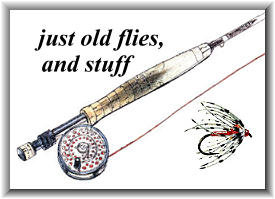The details surrounding the origins of The
Munro are murky at best. It appears to be
of Canadian origin. Julius P. Bucke, of
Sarnia, Ontario, Canada wrote the following
letter to Mary Orvis Marbury concerning a
cast of flies he liked to use:
"The cast I prefer for trout is the
Fiery Brown, made by Trout & Son. Body, bright
reddish mohair, ribbed with tinsel; hackle,
bright dark red; tail, strands of golden-pheasant
crest feather; wings, dark mallard.
I send you samples of the two others. They
are tied by myself. One has been called the
Munro; the original of it was found in a bush,
on a stream emptying into Lake Superior, by
a friend, who found it to work well, had it
repeated at Toronto, and gave me one for a
pattern. I have called it after him. Tail,
red ibis and mallard, dyed yellow; hackle,
yellow; body, bright green, ribbed with gold
tinsel; wings, red ibis, covered with wild
turkey. The other fly is the Lord Baltimore
modified. These flies will catch trout, and
so will others, but I always have had success
with them, and feel confident and like going
in to win when they are on the cast. Of course,
I always like to have a general assortment of
winged flies and hackles along, for, as a
Spiritualist once observed during his lecture
in this town, 'sometimes the spirits will work,
and sometimes they won't; it depends upon the
conditions.' Trout are fickle also."
The Munro evolved a bit between the late 1800s
and the publication of Ray Bergman's Trout
in 1938. The fly is generally the same, but the
one in Bergman's book appears to have yellow
mallard quill in the tail, while the one shown
in Mary Orvis Marbury's book shows yellow mallard
flank. I've done the Bergman version here.
Here's Bergman's recipe:
Tip: Gold tinsel.
Tail: Scarlet and yellow.
Body: Green floss.
Rib: Gold tinsel.
Wing: Scarlet with brown turkey stripe.
Hackle: Yellow.
~ Eric Austin
Credits: Favorite Flies and Their
Histories by Mary Orvis Marbury;
Trout by Ray Bergman.
|



